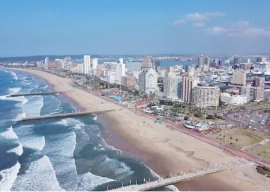
If the unprecedented rate of glacial retreat in the South Asian region is not checked, countries in the area are likely to turn highly food-insecure. Pakistan’s latest Climate Change Policy clearly indicates that freshwater resources in Pakistan are dependent on snow and glacial melting and monsoon rains; both of which are highly sensitive to climate change.
In 2000-2001, the country faced severe food scarcity because of lower-than-average rainfall. The worst ever drought in its history hit Pakistan, with the Balochistan and Sindh provinces suffering the most. The famine affected around 1.2 million people in 26 districts; 127 people died in Sindh due to dehydration and severe water shortages, whereas in the Nushki district in Balochistan, which had not received a single drop of rain in five years, 2 million animals were lost.
Gradually, the drought ended; but in 2004-2005 and 2009-2010, the country again faced moderate droughts. In late July of 2010, the country was suddenly inundated immediately after the drought period. The countrywide flooding was unprecedented and wreaked havoc incomparable to any other disaster of a similar nature in Pakistan’s history.
Himalayan Geography
South Asia – the monsoon’s corridor – is blessed with the world’s second largest frozen water sources: the Himalayas, spread over 2,400km from west to east. The Himalayas hosts some of the world’s tallest mountain systems, including the Karakorum, Hindu Kush and Pamir ranges. The Himalayas are also responsible for meeting the water needs of roughly one-fifth of the world’s population.
Retreating Himalayas
Glacial retreat is a phenomenon that scientists normally attribute to global warming; it is caused by an increase in the atmospheric concentration of greenhouse gases due to human activities such as deforestation.
Islamabad-based climatologist Arshad H Abbasi, who works at the Sustainable Development Policy Institute, rejects the notion that unprecedented melting in Himalayan glaciers can be attributed merely to global warming.
“Most of the glaciers in Karakorum are losing their ice rapidly because of human activity on and around them; specifically the usage of ‘dirty’ fuels,” Abbasi says; adding that the coal India burns to meet 70% of its energy needs contains 30-40% ash content, while international standards does not permit it to be over than 8-10%.
“[Furthermore,] since India and Pakistan are at war in Siachen, they have developed preliminary infrastructure like ports, helipads and pipelines to supply kerosene to their camps,” Abbasi informs.
In 1999, the Military Engineering Services of India reported that the military presence in Siachen is devastating for the glacier: satellite images confirmed cracks in the Saltoro Ridge, while a number of lake outbursts have emerged from the glacier, a clear evidence of its accelerating melt.
Vice President of World Meteorological Organization Asia, and author of Pakistan’s first ever National Climate Change Policy, Dr Qamaruz Zaman Chaudhry seconds Abbasi’s notion and says, “the presence of both armies at Siachen is accelerating a process which global warming and carbon soot deposits instigated.”
Changing rain patterns
In 2010, Siachen witnessed a huge cloudburst that ended up inundating the entire Indus Valley Basin. Abbasi reiterates that the flooding can be attributed to human activity in the area, rather than global warming.
Depleting crop productivity
Glacial retreat bodes ill for of all villagers in the region whose livelihoods are directly dependent on their cultivations.Punjab Water Council Director Rabia Sultan is of the view that the sharing of the Indus’ water resources between the provinces has been shrinking due to a depleting water table, which corresponds to the severe stress on water resources.
This is the reason behind shortages in water availability for both crops and domestic use in distant areas of Punjab.
As an example of the consequences of irregular water supply, consider the following example: In the area of Dajal in Rajanpur district, authorities stopped water supply to the Dajal canal in 2008. As a result, wheat cultivations on thousands of acres were ruined; within the next three years, wheat, maize, rice and other crops’ production dropped significantly by up to 40-50%.
“Small farmers who cultivate their crops on 5-10 acres of land have to bear the major brunt of this crisis,” says Qazi Sajjad Dajali, a farmer in Dajal. “Groundwater throughout the district, except in the Rajanpur and Jampur cities, is already sour. Villagers can neither utilise it for farming, nor for drinking,” Sajjad asserts.
A regional strategy is the need of the hour to combat future threats from climate change. Both India and Pakistan should decide to retreat from their glacial warzones and be more attentive to their preservation; in order that they may ensure the prosperity of agriculture, and food security in the region.
THE WRITER IS A JOURNALIST BASED IN ISLAMABAD AND WORKS FOR A PRIVATE TELEVISION BROADCASTING COMPANY
Published in The Express Tribune, June 18th, 2012.


















COMMENTS
Comments are moderated and generally will be posted if they are on-topic and not abusive.
For more information, please see our Comments FAQ